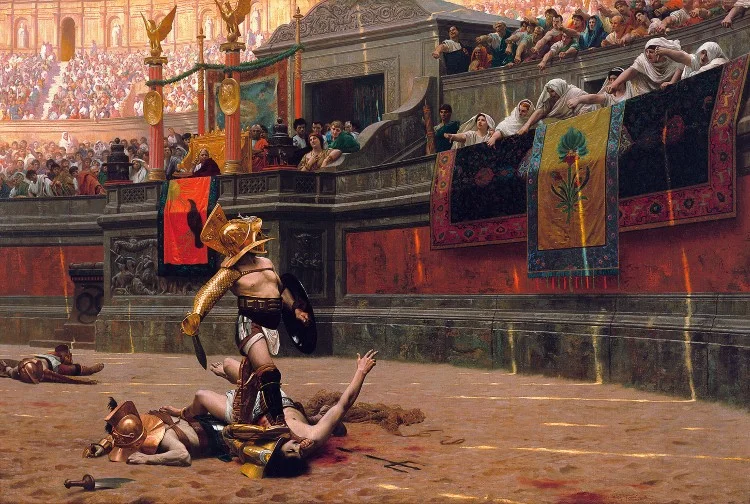

Gladiatorial games were hugely popular in ancient Rome, and gladiators could be widely admired and achieve great wealth. Though there are few literary descriptions of gladiatorial combat, gladiators are referenced in celebratory graffiti, inscriptions and artistic relics.
Gladiatorial combat dominates the popular perception of ancient Roman entertainment, a position scaffolded by films like Stanley Kubrick’s Spartacus (1960) and Ridley Scott’s Gladiator (2000), as well as older works like Jean-Léon Gérôme’s 1872 painting Pollice Verso.
These depictions have entrenched the rebellious Spartacus and emperor Commodus as legends of the arena, but there were other gladiators who achieved renown in their own day. Here are 10 famous Roman gladiators.
1. Spartacus
According to Livy, the earliest large-scale public entertainments in Rome were held in 264 BC at the Forum Boarium. By the 1st century BC, they had become established as an important way for politicians to gain public recognition and prestige. Spartacus, the most famous of Roman gladiators, trained in a gladiator school during this period.
Spartacus’s fame is owed to his leadership of a rebellion in 73 BC with an army of escaped slaves. According to Appian’s Civil Wars (1.118), the gladiator army resisted the legions of the Roman Republic for several years until Licinius Crassus assumed the praetorship. They were regarded as a source of terror. When his rebellion was foiled, 6,000 of the freed slaves were crucified along the Appian Way.
2. Crixus
One of Spartacus’s subordinate officers was a man named Crixus. Crixus and Spartacus are attributed by Livy with leading the revolt of gladiators from their gladiator school in Capua. When Crixus was killed in 72 BC, slain by Quintus Arrius alongside 20,000 of his men, Spartacus ordered 300 Roman soldiers slaughtered in his honour.

Pollice Verso, Jean-Léon Gérôme, 1872
Image Credit: Public Domain
3. Commodus
Roman sports, called the ludi, existed for the spectators. Audiences took games seriously, valuing athleticism and technique, but they were not participants. For its perceived effeminacy and contemptible Greekness, disgrace would attend any Roman citizen who either was or married a sportsman or performer. This did not stop emperor Commodus.
Nero might have forced his senators and their wives to fight as gladiators, but Commodus, who ruled between 176 and 192 AD, himself donned a gladiator’s garb and entered the arena. According to Cassius Dio, Commodus fought gladiators who usually wielded wooden swords while he thrust with his lethal, steel one.
Commodus was assassinated by senators wary of being humiliated by the emperor. The day before he was due to accept their honours while dressed as a gladiator, senators bribed the wrestler Narcissus to strangle Commodus while he was taking a bath.
4. Flamma
Flamma was a Syrian gladiator who fought in the arena during the reign of Hadrian, in the early 2nd century AD. Flamma’s gravestone in Sicily records that he died at the age of 30. He fought 34 times in the arena, a much greater number than most other gladiators, and he won 21 matches. Most notably, he won his freedom four times but refused it.

Gladiator mosaic from Kourion, Cyprus.
Image Credit: imageBROKER / Alamy Stock Photo
5. Spiculus
Emperor Nero made a favourite of Spiculus. He received wealth and land from Nero, including “properties and residences equal to those of men who had celebrated triumphs,” according to Suetonius in his Life of Nero. Additionally, Suetonius reports that prior to his death by suicide, Nero called upon Spiculus to slay him, “and when no one appeared, he cried ‘have I then neither friend nor foe?’”
6. Priscus and Verus
Only one contemporary account of a gladiatorial match survives, part of a series of epigrams by Martial written for the opening of the Colosseum in 79 AD. Martial describes an epic confrontation between the rivals Priscus and Verus, the main entertainment of the opening day games. After hours of wearying fighting, the pair laid down their weapons. They let the emperor Titus decide their fate, who awarded them their freedom.
7. Marcus Attilius
Marcus Attilus, whose name is recorded on graffiti in Pompeii, may have entered the arena in order to pay off his debts. He earned celebrity after defeating a man who had won 12 of 14 previous fights, and then defeated another opponent with an impressive record. Usually, the longer somebody was a gladiator, the less likely was their death in the arena.
As Alison Futrell writes in The Roman Games: Historical Sources in Translation, “Because of the audience’s preference for equal matches, a veteran of twenty of thirty bouts had fewer opponents at his level; he was also more costly for an editor to acquire. The frequency of matches for him was thus lower.”
8. Tetraites
Graffiti in Pompeii describes Tetraites as a bare-chested gladiator who appears to have been popular across the Roman empire. Glass vessels, including one found in southeast France in 1855, record Tetraites’ battle against the gladiator Prudes.
 Listen Now
Listen Now9. Amazon and Achilla
Two female gladiators named Amazon and Achilla are depicted on a marble relief from Halicarnassus in Turkey. In the intensely gendered realm of Roman games, it was generally a scandalous transgression for women to perform. When female gladiators are described by Roman writers, it’s usually to condemn the practice as vulgar.
According to the Greek inscription, Amazon and Achilla were both granted a reprieve before the end of their combat. The relief shows the women heavily armed with greaves, blades and shields.
10. Marcus Antonius Exochus
Marcus Antonius Exochus was a gladiator born in Alexandria, Egypt, who came to Rome in order to fight in games celebrating Trajan’s posthumous triumph in 117 AD.
On his fragmentary tomb, it records that: “On the second day, as a novice, he fought with Caesar’s slave Araxis and received missio.” This was a privilege, where combat is stopped before either fighter is slain. He was probably not especially acclaimed, but he was able to retire as a Roman citizen.













